Layman D. Biology Demystified: A Self-Teaching Guide
Подождите немного. Документ загружается.


Revisiting the liver once more, we can say that it has numerous other
critical body functions, in addition to the production of bile. First among
these is detoxification (dee-TAHKS-ih-fih-KAY-shun) – ‘‘the process of tak-
ing poison out of ’’ the bloodstream. The liver cells help detoxify (dee-
TAHKS-ih-feye) drinking alcohol, for instance, so that it is broken down
into sugar and water without toxifying (‘‘poisoning’’) the brain! [Study sug-
gestion: When we say that a person is drunk, what does that imply, with
regards to the associated function of the liver?]
Summarizing all of the above, we can say that the duodenum, as the first
segment of the small intestine, receives chyme from the stomach, bile from
the liver and cholecyst, and pancreatic juice from the pancreas. As a result,
the chemical digestion of all three basic types of foodstuffs – carbohydrates,
lipids, and proteins – is essentially completed within the small intestine. Lying
downstream from the liver and pancreas entry point the duodenal papilla
are the jejunum (jeh-JOO-num) and the ileum (IL-ee-um).
The jejunum and ileum basically complete the processes of chemical diges-
tion and absorption of nutrients that began in the duodenum.
We thus have the following simple summary equation:
SMALL INTESTINE ¼ Duodenum þ Jejunum þ Ileum
THE COLON: OUR LARGE INTESTINE
The last major section of the digestive tube is the colon (KOH-lun) or ‘‘large
intestine.’’ The colon (large intestine) is a wide-diameter, folded tube, about 6
feet (2 meters) in length in an average-sized human adult (see Figure 19.5).
The colon begins with the cecum (SEE-kum), a ‘‘blind’’ (cec) or dead-ended
pouch that has the vermiform (VER-mih-form) appendix or ‘‘worm-like
attachment’’ hooked to its base. The vermiform appendix is basically a
solid attachment of modified lymphatic tissue (Chapter 17) that plays a
minor role in the body’s immune or self-defense system.
Liquid chyme from the ileum of the small intestine pushes through the ileo-
cecal (il-ee-oh-SEE-kul) sphincter. Once within the cecum, the chyme begins
to undergo an extensive drying out process, wherein large amounts of water
and salt (H
2
O) are absorbed. In addition, there are beneficial bacteria in the
colon that produce a variety of B-vitamins, as well as sulfur-containing
amino acids, which are also absorbed.
Due to this drying out process, chyme is solidified into feces (FEE-seez)
within the colon. Besides H
2
O, feces also contain a significant percentage of
fecal (FEE-kal) bacteria and dietary fiber (actually undigested cellulose mate-
rial).
CHAPTER 19 Nutrition/Digestive System 337
[13:27 13/6/03 N:/4058 LAYMAN.751/4058-Alltext.3d] Ref: 4058 Layman: Biology Demystified All-text Page: 337 1-388
3, Order
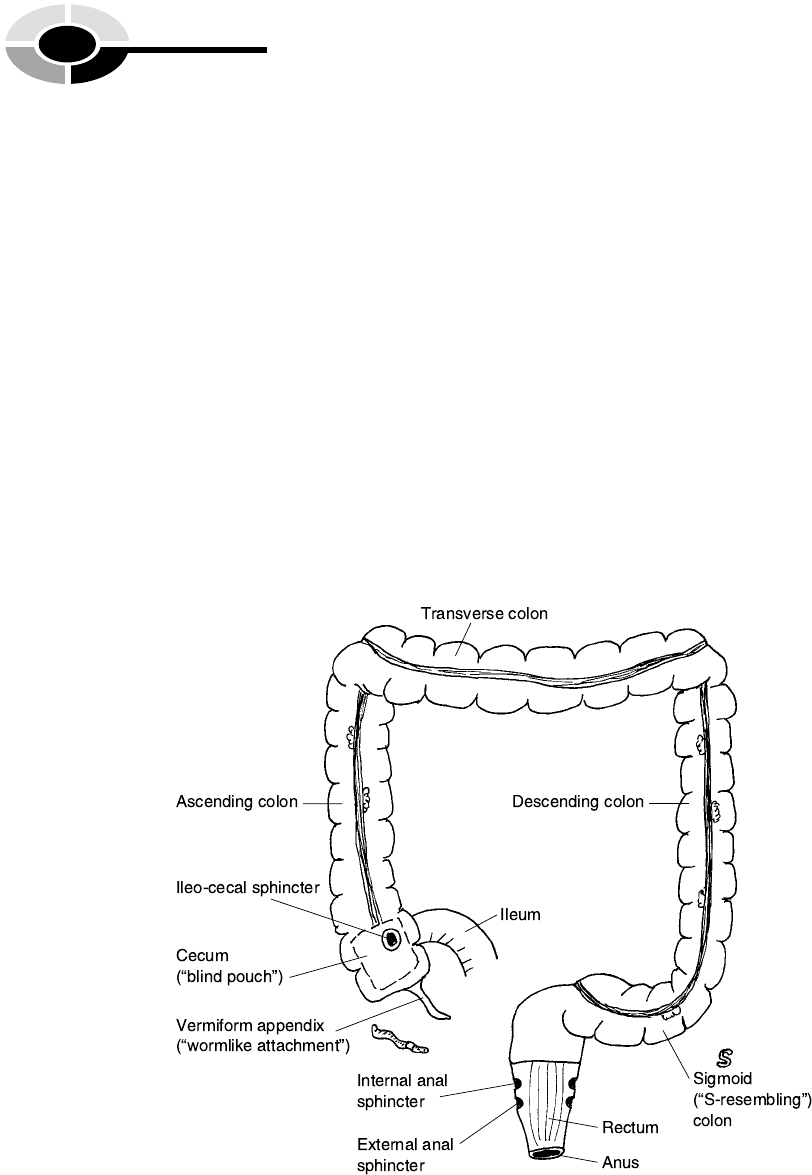
Looking at Figure 19.5, you might well ask yourself, ‘‘How does chyme/
feces in the cecum, which is way down at the bottom of the large intestine,
move up to the other parts of the colon?’’ Good question! The answer is, by
mass peristalsis (pear-ih-STAHL-sis). Peristalsis literally means ‘‘a constric-
tion’’ (-stalsis) ‘‘around’’ (peri-). Formally defined, then, peristalsis is a con-
striction (narrowing) around a particular point of some tube, due to the
contraction of a circular ring of smooth muscle around the tube. Mass peri-
stalsis is thus the simultaneous constriction or narrowing of a large number
of directly neighboring points along the large intestine wall, such that the
heavy mass of the feces is pushed on to the next section of the colon. [Study
suggestion: Either in your imagination, or for real, get a large tube of tooth-
paste. Turn it upside down, and remove the cap. Now, make a ring around
the upper part of the tube using both your hands. Count one . . . two . . .
three . . . . Constrict your fingers hard around the tube! What do you
observe? This constriction at a single point is a crude model of peristalsis.
Think. How could you use the same basic elements to model mass peristalsis
in the colon? If you phoned up several of your friends, what could you do?]
[13:27 13/6/03 N:/4058 LAYMAN.751/4058-Alltext.3d] Ref: 4058 Layman: Biology Demystified All-text Page: 338 1-388
PART 4 Anatomy and Physiology of Animals
338
Fig. 19.5 The human colon (large intestine).
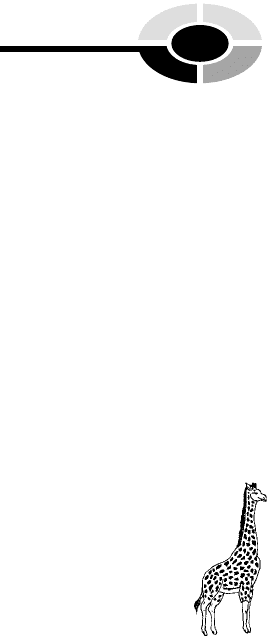
After the cecum, next in sequence are the ascending colon (which goes
upward), transverse colon (which runs sideways), and the descending colon
(which goes downward). Sigmoid (SIG-moyd) means ‘‘S-resembling.’’ Hence,
the sigmoid colon is the S-resembling portion of the large intestine coming
right after the descending colon.
The sigmoid colon snakes down into the rectum (WRECK-tum), a mus-
cular-walled, ‘‘straight’’ (rect) tube that empties feces into the anus. There are
two sphincters within the rectum. The higher one, called the internal anal
sphincter, is not under our conscious control. The internal anal sphincter
tends to open whenever mass peristalsis has moved some feces down into
the upper portion of the rectum.
Fortunately, for us, there is also a ring of voluntary striated (cross-striped)
muscle, positioned in the lower portion of the rectum. This muscular ring is
called the external anal sphincter. Its contraction and relaxation is very much
under our conscious control (at least, ever since we were first ‘‘potty-
trained’’)! Therefore, we can usually choose the time and place where we
will consciously relax this lower sphincter and carry out defecation (egestion).
Let us end by summarizing in words the parts of the large intestine:
COLON=Cecum+Ascending colon+Transverse colon
þ Descending colon+Sigmoid colon+Rectum
Too Many, or Too Few Calories?
Way back in Chapter 4 we talked about the Chemical Balance of Life, and
its relationship to cellular respiration or metabolism. Recall that in the
catabolism (breakdown) of chemical foodstuffs (such as glucose molecules),
free or kinetic energy is released and tied to the production of more cell
ATP. Obviously, these topics are closely related to our current discussion,
since digestion is, in fact, defined as the chemical and physical breakdown
of food. Similarly, nutrition is the process of nourishing or feeding the body
cells.
THE CONCEPT OF CALORIES
The nutrients that humans eat, say, in a candy bar, are all associated with a
certain number of calories (KAL-or-ees). A calorie is technically a unit for
describing the amount of ‘‘heat’’ (calor) that is released during the break-
CHAPTER 19 Nutrition/Digestive System 339
[13:27 13/6/03 N:/4058 LAYMAN.751/4058-Alltext.3d] Ref: 4058 Layman: Biology Demystified All-text Page: 339 1-388
4, Order
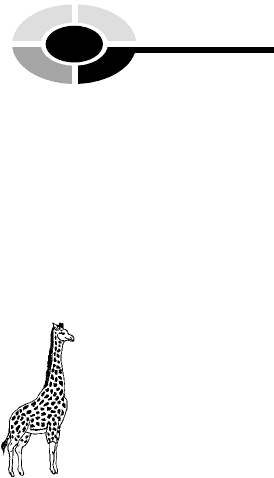
down of food. In nutrition, we generally use the ‘‘large calorie’’ or kilocalorie
(KILL-uh-kal-ur-ee) – the amount of heat energy released measured in
‘‘thousands’’ (kilo-) of calories. A candy bar, for instance, may contain 670
kilocalories of heat energy, when it is consumed.
THE CONCEPT OF CALORIC BALANCE
An important principle of Biological Order in humans and other animals is
the notion of caloric (kuh-LOR-ik) balance. Caloric balance is a condition
where the number of kilocalories consumed in food per day exactly equals the
number of kilocalories burned in exercise per day. Summarizing, we have:
CALORIC BALANCE : Number of kilocalories consumed/day
¼ Number of kilocalories burned/day
Caloric balance is desirable, therefore, whenever we wish to maintain our
current body weight. It logically follows that whenever one wishes to either
gain or lose weight, then some degree of Biological Disorder must be inserted
into the scheme, such that the caloric balance is disrupted.
When the number of kilocalories consumed per day significantly exceeds
the number burned during exercise, there is a net excess of kilocalories. Some
of these excess kilocalories are stored as extra glycogen deposits in liver and
muscle cells, and some of it is stored as extra lipid within our adipose tissue
cells. The net result, of course, is that we (gulp!) gain weight and often get
fatter!
Conversely, to lose weight, the number of kilocalories burned during daily
exercise must exceed the number consumed in foodstuffs (no matter what the
current fad diet books tell you!).
Quiz
Refer to the text in this chapter if necessary. A good score is at least 8 correct
answers out of these 10 questions. The answers are listed in the back of this
book.
1. For humans, eating grass would not be a good way of obtaining
nutrients, because:
(a) Grass contains no nutrient molecules
(b) Blades of grass cannot be digested by any known type of animal
[13:27 13/6/03 N:/4058 LAYMAN.751/4058-Alltext.3d] Ref: 4058 Layman: Biology Demystified All-text Page: 340 1-388
PART 4 Anatomy and Physiology of Animals
340
5, Order

(c) Human stomachs and small intestines lack the key enzymes
necessary to break down cellulose
(d) Grass can’t even be chewed by human beings!
2. Ingestion is the exact opposite of what process?
(a) Egestion
(b) Digestion
(c) Absorption
(d) Mastication
3. The movement of nutrients from the interior of the digestive tube into
the blood:
(a) Absorption
(b) Secretion
(c) Defecation
(d) Ingestion
4. The chemical digestion of carbohydrates begins in the mouth, owing to
the presence of:
(a) Hydrochloric acid
(b) NaHCO
3
(c) NaCl
(d) Salivary amylase
5. A thick, soupy mass of partially digested material found in the stomach
and small intestine:
(a) Bolus
(b) Cud
(c) Chyme
(d) Feces
6. The first segment of the small intestine:
(a) Jejunum
(b) Vermiform appendix
(c) Duodenum
(d) Cecum
7. Technical term for the gallbladder:
(a) Gallicule
(b) Cholecyst
(c) Cystic duct
(d) Hepatic accessory organ
CHAPTER 19 Nutrition/Digestive System 341
[13:27 13/6/03 N:/4058 LAYMAN.751/4058-Alltext.3d] Ref: 4058 Layman: Biology Demystified All-text Page: 341 1-388
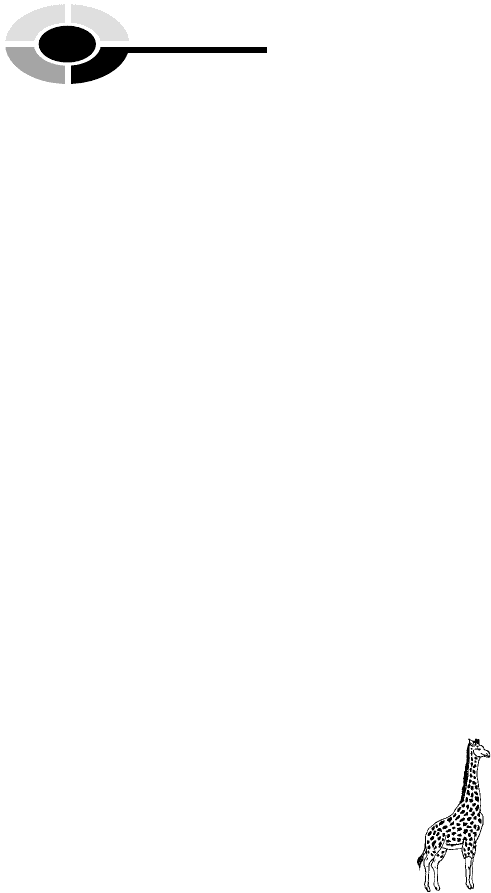
8. Regulates the emptying of both the common bile duct and the
pancreatic duct into the duodenum:
(a) Pyloric sphincter
(b) Microvillus
(c) Hepatopancreatic sphincter
(d) Ileo-cecal sphincter
9. The large intestine begins with the dead-ended _____:
(a) Sigmoid colon
(b) Rectum
(c) Cecum
(d) Transverse colon
10. A critical structure that allows defecation to be voluntary:
(a) Vermiform appendix
(b) Internal anal sphincter
(c) Descending colon
(d) External anal sphincter
The Giraffe ORDER TABLE for Chapter 19
(Key Text Facts About Biological Order Within An Organism)
1. ____________________________________________________________
2. ____________________________________________________________
3. ____________________________________________________________
4. ____________________________________________________________
5. ____________________________________________________________
[13:27 13/6/03 N:/4058 LAYMAN.751/4058-Alltext.3d] Ref: 4058 Layman: Biology Demystified All-text Page: 342 1-388
PART 4 Anatomy and Physiology of Animals
342
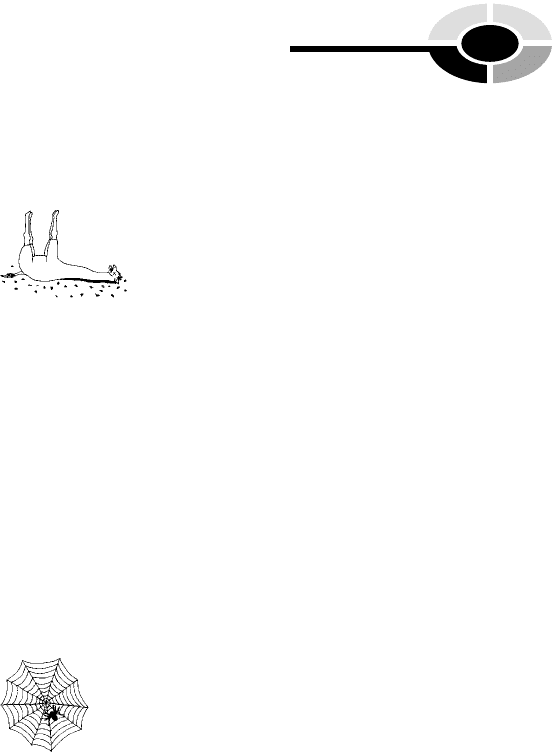
[13:27 13/6/03 N:/4058 LAYMAN.751/4058-Alltext.3d] Ref: 4058 Layman: Biology Demystified All-text Page: 343 1-388
The Dead Giraffe DISORDER TABLE for Chapter 19
(Key Text Facts About Biological Disorder Within An Organism)
1. ____________________________________________________________
2. ____________________________________________________________
3. ____________________________________________________________
4. ____________________________________________________________
5. ____________________________________________________________
The Spider Web ORDER TABLE for Chapter 19
(Key Text Facts About Biological Order Beyond the Individual Organism)
1. ____________________________________________________________
CHAPTER 19 Nutrition/Digestive System 343

[13:27 13/6/03 N:/4058 LAYMAN.751/4058-Alltext.3d] Ref: 4058 Layman: Biology Demystified All-text Page: 344 1-388
344
CHAPTER
20
Urine and (Gulp!)
Sex in Animals
Chapter 19 told us all about digestion and nutrition, two essential functions
for the survival of the individual organism. Now, in Chapter 20, we consider
both the urinary (YOUR-ih-nair-ee) and reproductive (ree-proh-DUCK-tiv)
systems. The urinary system literally ‘‘pertains to’’ (-ary) ‘‘urine’’ production,
storage, and excretion from the individual body. The reproductive system in
the male and female, on the other hand, is literally about ‘‘producing’’ a new
organism, ‘‘again’’ (re-). For most animals, this implies using the genital
(JEN-ih-tal) organs to ‘‘beget or produce’’ (genit) sexually.
The Genitourinary (Urogenital)
System Concept
In humans and other mammals, it is appropriate to speak not just of the
urinary and reproductive systems alone but of a combined genitourinary
Copyright 2003 by The McGraw-Hill Companies, Inc. Click Here for Terms of Use.
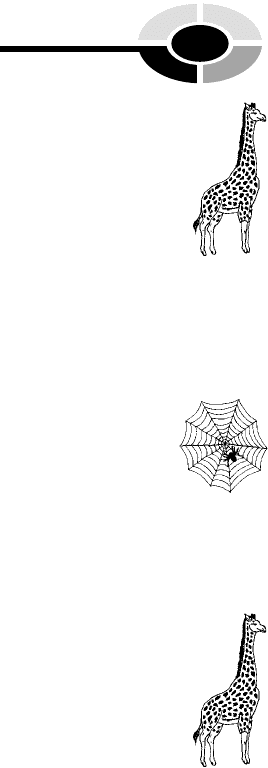
(JEN-ih-toh-ur-ih-nair-ee) or urogenital (UR-oh-jen-ih-tal) system. This is
because many of the structures of the urinary and reproductive (genital)
organs are shared in common. Consider, for example, the penis (PEA-nis)
in males. The penis is a spongy ‘‘tail’’ (pen)-like structure that serves both to
carry urine out of the body, as well as deliver spermatozoa (sperm cells) to an
ovum (mature egg cell) for reproduction.
Major Urinary Structures in Animals
In all vertebrates, the major organs of urine excretion are the kidneys.In
humans, a pair of bean-shaped kidneys are located along either side of the
vertebral column, deep within the back.
KIDNEY ANATOMY
Figure 20.1 provides an overview of renal (REE-nal) or ‘‘pertaining to’’ (-al)
‘‘kidney’’ (ren) anatomy. The kidney is encased within the renal capsule,a
thin membrane of fibrous connective tissue. The kidney, itself, is subdivided
into three major areas or zones. The outermost zone is called the renal cortex.
Much as the cerebral cortex forms a thin ‘‘bark’’ over the surface of the
cerebrum (Chapter 14), the renal cortex does the same for the kidney. The
‘‘middle’’ (medull) area is the renal medulla (meh-DEW-lah). And the deepest
zone is the renal pelvis (PEL-vis). The renal pelvis is a broad, bowl-shaped sac
that receives the urine as it flows from the renal cortex and medulla. And
carrying the collected urine of the renal pelvis is the ureter (YOUR-eh-ter).
Within the renal cortex are millions of nephrons (NEF-rahns). The
nephrons are the major microscopic functional units of the kidney. It is the
nephrons that are actually responsible for formation of urine from the blood.
Each nephron begins with a glomerulus (gluh-MAHR-yew-lus). The glomer-
ulus is a tiny, red-colored collection of renal capillaries. This structure gets its
name from its resemblance to a little red ‘‘ball of yarn’’ (glomerul). The blood
pressure pushing against the walls of the capillaries in each glomerulus,
causes a filtration of fluid out of the glomerulus, and into the adjoining
group of urinary tubules (TWO-byools) – ‘‘tiny urine tubes.’’
The urinary tubules from each group of neighboring nephrons eventually
empty into a common passageway called a collecting duct. A number of
collecting ducts pass down together through the renal medulla. They create
the renal pyramids, which are pointed at their bottom tips like the rather
CHAPTER 20 Urine and Sex in Animals 345
[13:27 13/6/03 N:/4058 LAYMAN.751/4058-Alltext.3d] Ref: 4058 Layman: Biology Demystified All-text Page: 345 1-388
1, Order
1, Web
2, Order
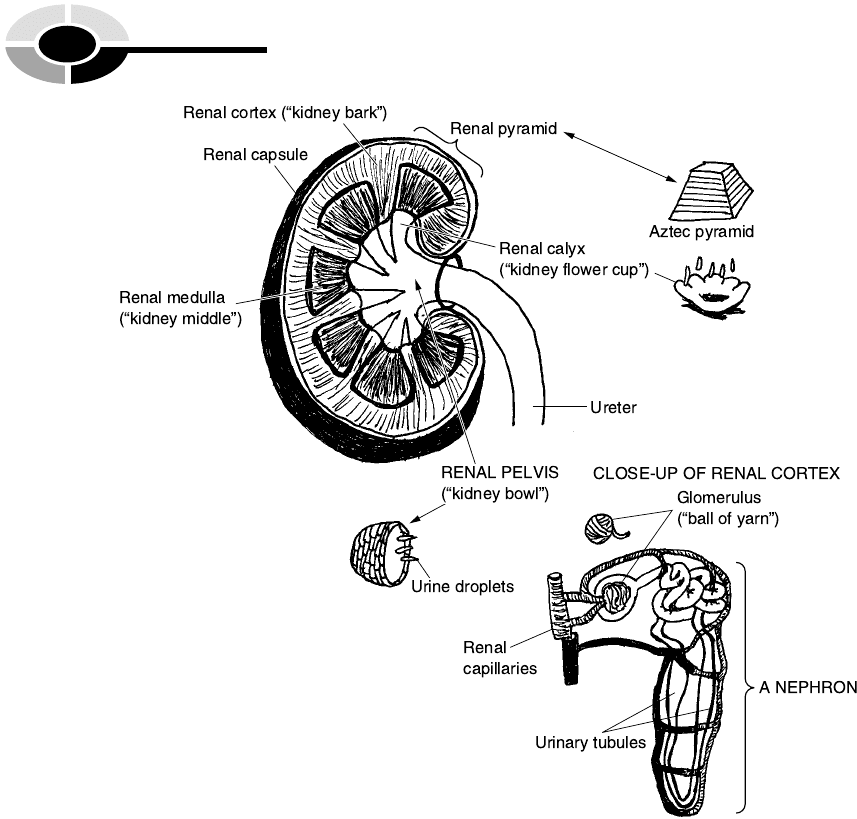
blunt pyramids constructed by the Aztecs or Inca Indians. The tip of each
renal pyramid drips urine into a renal calyx (KAY-licks), or ‘‘kidney flower
cup.’’ And the urine from each calyx eventually flows into the body of the
renal pelvis, before it leaves the kidney via the ureter.
THE URINARY PATHWAY
Figure 20.2 shows the rest of the urinary pathway, lying beyond the kidney.
The right and left ureters both dump urine into the urocyst (YUR-oh-sist)or
urinary bladder (cyst). The urocyst (urinary bladder) is a hollow, muscular-
walled pouch that temporarily stores the urine before it is excreted.
[13:27 13/6/03 N:/4058 LAYMAN.751/4058-Alltext.3d] Ref: 4058 Layman: Biology Demystified All-text Page: 346 1-388
PART 4 Anatomy and Physiology of Animals
346
Fig. 20.1 An overview of renal anatomy.
